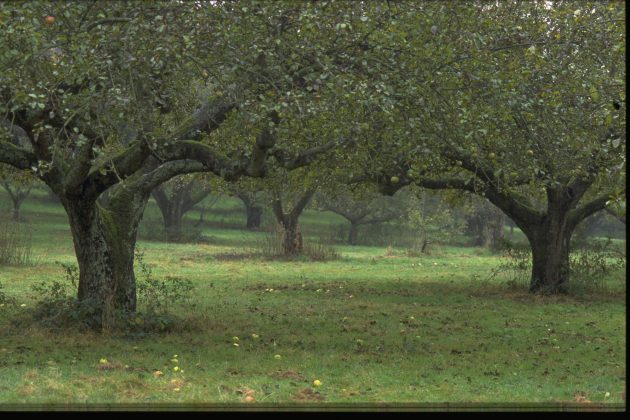With scores to choose from in the UK, Ursula Buchan believes there is a delicious variety of apple tree for everyone
There are three certain things in life: death, taxes and the presence of at least one apple tree in the garden you get when you move house. Of all ‘top fruits’ (that is tree fruits, as opposed to ‘soft fruits’ such as blackcurrants, gooseberries and strawberries), apples are the most widely planted. And it isn’t difficult to see why. They are less picky about how much sunshine they get than pears, peaches, nectarines and apricots, less prone to bird damage than cherries, more useful and storable than plums and infinitely more delicious than medlars.
Their blossom in April and early May is the most beautiful of any top fruit; even lovelier than that of quince or cherry. And older trees, on traditional ‘non-dwarfing’ rootstocks, acquire the kind of gnarled individuality that delights tree-climbing children and is so satisfying to the rest of us. However, unless the tree is a ‘Bramley’s Seedling’ cooking apple, which is instantly recognisable because of its large size, green skin and odd shape, so familiar from supermarket shelves, you will probably be stumped as to what variety you’ve got, and therefore when to pick it and how long the fruit will store.
What sort of apple tree lives in your garden?
In the National Fruit Collection at Brogdale in Kent, there are more than 2,000 cultivated varieties of apples, and scores available from specialist fruit nurseries. As a rough rule of thumb, the earlier in the season that an apple comes to maturity – and you know this moment when the fruits begin to drop onto the ground, even on still days – the shorter the time it is likely to ‘keep’, even in good conditions. By this, I mean a fridge or cool but frost-free shed. For example, ‘Discovery’, a reliable, attractive dessert apple, needs to be eaten within two or three weeks of its maturity in late August or early September, for it softens quickly. A ‘Newton Wonder’, on the other hand, will keep until well into the new year, starting off as a sharp ‘cooker’ and mellowing to a sweetish dessert apple.

If you have an apple tree in the garden, it may well be a ‘Bramley’s Seedling’, whose fruit is easily recognisable
Most varieties that don’t drop their fruits until mid-October, should keep until December at least, in reasonable storage conditions. If you have a great many, you may well need to make or buy wooden slatted racks on which to put them, and you will have to harden your heart and set mousetraps. Some varieties, such as the culinary apple, ‘Annie Elizabeth’, keep well into the following year. A friend, who judges fruit at local flower shows, told me how he came across a plate of perfectly acceptable ‘Annie Elizabeth’ on a show bench in an early summer show. Puzzled, he discovered that it had been picked the autumn before and stored in a cellar.
The growth of apple events
Even if you scour catalogues and apple websites, you may still be at a loss as to the name of your unknown tree. Fortunately, this is the perfect moment to ask someone who knows. All over the country from mid-September until late October, but particularly on Apple Day, Saturday, 21 October, local horticultural societies, WIs, large public gardens, community orchards and specialist fruit nurseries will be holding events. Here, along with a lot of jolly, fruit-related activities for children and adults, you will find an expert or two on hand to identify unknown apples. You’ll need to take a few representative fruits along to show them, and preferably pictures of the tree as well.
Those local experts can advise on which varieties do well in your district, since October is also the time to think of ordering apple trees for planting in the dormant season from late November to early March. Because the range of apples in shops is so pitifully meagre, the home gardener has every incentive to plant something more interesting and suitable. The best places to try are specialist fruit nurseries that offer mail order, such as Keepers Nursery in Kent, Blackmoor Nurseries in Hampshire or Pomona Fruits in Essex. They will also give advice on suitable rootstocks, pollination partners and so on. I would never taste delectable varieties such as ‘Epicure’, ‘Sunset’, ‘Kidd’s Orange Red’ or ‘Scrumptious’ if I hadn’t taken the trouble to plant the trees myself.
If you enjoyed our apple tree feature…
The Field is packed with content for gardeners, including Ursula Buchan on how to deal with weeds and the appeal of coloured foliage, plus our guide to the best gumboots for those messy jobs.





